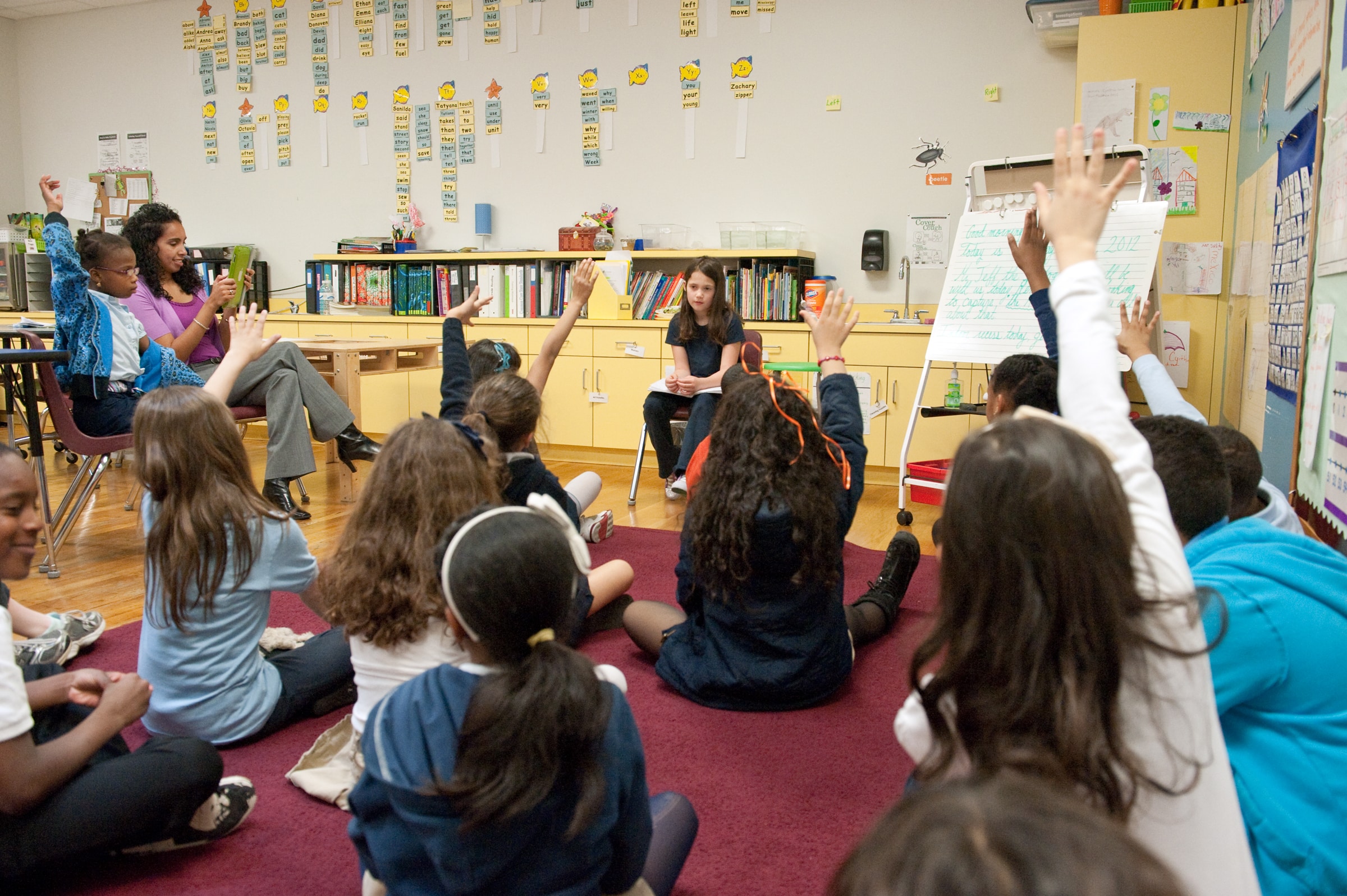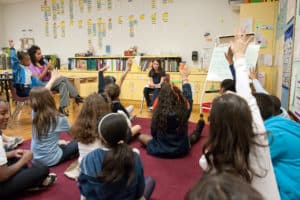The Art of Commenting

 Teaching Children to Make Caring Comments during Morning Meeting Sharing
Teaching Children to Make Caring Comments during Morning Meeting Sharing
On a late spring morning, Mr. Marino’s fourth graders are gathered quietly on their Morning Meeting rug, all eyes on Joe, whose turn it is to share.
“I played a basketball game on Saturday,” Joe says. “We lost, but my team played really hard together and I think I played my best. I’m ready for questions and comments.”
Several hands go up. Joe chooses Amanda. “You sound like you felt good about the game even though you didn’t win,” she says.
Taking in his classmate’s insight, Joe cocks his head thoughtfully. Then he grins. “Yeah,” he says. “Thanks, Amanda.”
Joe calls on three more classmates, fielding another comment and two questions, and then ends his Sharing.
So goes Sharing in a classroom using the Responsive Classroom approach. This daily routine lets children practice many communication skills while helping to build a caring classroom community. During Sharing, several children briefly share some personal news and then invite questions and comments from their classmates.
Of all the skills involved in Sharing, offering respectful comments is perhaps the hardest for children to learn—and for teachers to teach. If children consistently offer good questions during Sharing, it can be tempting to just let comments go. But commenting offers unique opportunities for children to learn important social and academic skills. Here are some thoughts about comments and a basic plan for teaching children to offer good ones.
Why is commenting harder?
Making caring comments may be harder than asking respectful questions because question-asking is essentially egocentric. Even respectful questions focused on the sharer’s news usually arise from the listener’s own wish to know more about something.
Good commenting, by contrast, requires more empathy—taking another’s perspective, focusing on that person, and thinking about what will help her or him feel cared for at that moment. When we empathize, we think more about what the other person needs to hear and less about what we want to know. It’s a critical social skill that helps children succeed in their roles as caring classmates, friends, family members, and citizens.
Because the capacity to express empathy develops as children mature, younger children usually find commenting more difficult than do older children. But there are developmental exceptions to this rule. For example, thirteen-year-olds, absorbed in the intense emotional and social struggles of adolescence, may find expressing empathy more difficult than when they were younger.
It’s important to consider children’s developmental age when framing our expectations during Sharing. At all ages, however, children can be stretched to learn empathetic behaviors, as surely as they can learn to add, read, and write. All they need is good teaching—and lots of practice.
When do you teach commenting skills?
In the Responsive Classroom approach, Sharing is one component of a daily Morning Meeting, which is introduced early in the school year (see box below). Children learn the Morning Meeting components one at a time, in the order used during the meeting—except that Sharing is taught last. This is because Sharing works best when children have already begun to develop the sense of trust and comfort that comes from learning and practicing the other components together.
Because offering comments is typically harder than asking questions, some teachers prefer introducing comments separately, and only after children are comfortable asking respectful questions.
The first teaching
The Morning Meeting Book by Roxann Kriete offers detailed information on teaching all the Sharing skills. Here’s a summary of the basic steps for introducing children to commenting. It is most effective to cover these steps in more than one Morning Meeting, keeping in mind your students’ capabilities and needs.
1. Discuss what a comment is and what makes a good one. Give examples showing the difference between a question and a comment: A question asks something about a sharer’s news (When will you be walking your puppy on a leash?); a comment says something (You sound a little nervous about taking care of the puppy). Explain that good comments:
- Always make the sharer feel listened to and supported in a caring, positive way. Older children might engage in an extended discussion about the power of empathetic comments. For younger children, a simple statement may do: “Good comments let our friends know that we’ve listened to them and that we’re thinking in positive ways about how they feel.”
- Always focus on the sharer, rather than turning attention to the responder: Kindergartner Danny shares news about his trip to the emergency room to get stitches after a fall from his bike. Rather than talk about her own hospital experience, Michaela comments, “I bet you’re glad you could keep your teddy bear with you.”
- May notice and appreciate a detail: Lauren mentions that the dog her family just adopted was separated from her owner during Hurricane Katrina. “I think it’s nice,” Dennis comments, “that you’re rescuing a dog who lost her home.”
- May respond to how the sharer seems to feel about his or her news: “You sound really happy,” offers Jesse when Eric excitedly shares the news that he’s going fishing with his grandfather.
2. Offer your own Sharing. Choose news that conveys emotion along with intriguing details, and tell the children you want no questions—only comments: “This weekend I took a hike in the state park with my family. I don’t like heights, but I climbed up some steps and a few big rocks to get to a viewing platform. My knees were shaky, but we could see so far away! The cars looked like toys. I’m ready for comments.”
3. Explain what sorts of comments listeners might make. “You might comment on some detail I included, or you could notice how I seemed to feel about my climb to the platform.”
4. Brainstorm comments with the class. If the children need help getting started, step into the listener’s role and offer a few of your own comments, such as “I think it’s brave that you climbed up there when you don’t like heights” or “You sound really excited about what you could see from up there.”
5. Do separate questions and comments. During the next Morning Meeting Sharing, brainstorm comments as a class. Then let the sharer invite two questions from individual children: “Now I’m ready for two questions.”
6. Invite individual comments. In their next Sharing, have children raise their hands if they have a comment for the sharer. Older children can each write a comment on a sticky note, which you can give to the sharer to enjoy later.
Re-teachings
Empathetic commenting is an art requiring many complex skills. Children must listen attentively; note and interpret a classmate’s words, body language, and tone; remember what they’ve heard; and formulate a relevant and respectful observation or affirmation. Children will need more than one lesson to learn these skills, just as they need more than one lesson to learn multiplication or paragraphing.
To give children the support they’ll need, plan for occasional refresher teachings of the basics, and be ready to step in with mini-lessons if children are having trouble with a particular aspect of commenting. A common problem is for children to respond to a Sharing by launching into their own related story. For example, when the sharer tells a story about her new puppy, a classmate comments, “I have a puppy, too, and yesterday, he…” Listen carefully during every Sharing so you can redirect such comments with gentle but firm words: “That sounds like interesting news about you, Josh. Perhaps you’ll tell us about it when it’s your turn to share tomorrow. For now, you can make a comment or ask a question about Ellen’s puppy.”
The “Me, too!” strategy is another way to help younger children acknowledge a common experience without diverting all attention to themselves. Right after the Sharing, ask if anyone else has had a similar experience. Children can raise their hands, call out “Me, too!”, or point to themselves and then the Sharer. Once they’ve released their “Me, too!” energy, the children will be better able to step outside themselves when the sharer asks for questions and comments.
Offering your own comments during Sharing lets you unobtrusively model for the children, while also conveying that you’re interested in them and their news. But let students respond first, and take care not to comment on every Sharing. Otherwise, you may convey that exchanges aren’t really valid until the teacher has spoken.
Teaching the art of expressing empathy
Learning to listen well and make caring comments is an art that will take children many years to master. Offering respectful comments during Morning Meeting Sharing gives them practice in the necessary skills. Commenting also nurtures the sense of belonging and safety that comes with being known and respected by one another. It’s in such inclusive, supportive environments that children truly thrive.
Morning Meeting
The daily Morning Meeting is a powerful tool for building community and integrating the teaching of social and academic skills. For around thirty minutes, teacher and students gather in a circle and help one another transition from home to the new day of learning.
The four meeting components, in the order in which they’re done:
- Greeting: Everyone is greeted by name, sometimes along with handshaking, chanting, clapping, etc.
- Sharing: Students share important personal news. Listeners offer clarifying questions or empathetic comments.
- Group Activity: All join in a brief, lively activity that fosters group cohesion (singing, playing a cooperative game, etc.).
- Morning Message: Children read the message chart their teacher has written, which helps the children focus on the day’s work.
by Marlynn K. Clayton
